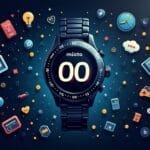Smart Fitness Tools That Fit Every Athlete’s Routine: Unlock Ultimate Wellness with Top Sports Wearables Revolutionizing Optimal Health Monitoring and Balance in 2025
Are You Still Using Last Season’s Fitness Tracker? Discover the Top Wearables Revolutionizing Optimal Health Monitoring in 2025 for achieving your best wearables sports fitness goals. With wearable tech advancing at an incredible pace, it’s time to upgrade and unlock ultimate wellness with top sports wearables that fit every athlete’s routine.
Introduction
In recent years, the market for wearable technology has seen tremendous growth, driven by consumers’ increasing interest in fitness tracking and health monitoring. As a result, numerous innovative products have emerged to cater to diverse user needs and preferences. In this article, we will delve into the latest developments in sports wearables, highlighting key features, benefits, and trends that can help you make informed decisions about selecting the best wearable device for your unique sports fitness goals.
Understanding Wearable Technology
Wearable technology encompasses a broad range of devices designed to be worn on or near the body. These devices collect data related to physical activity, sleep patterns, nutrition intake, and other health metrics, providing valuable insights into an individual’s overall well-being.
Key Components of Wearables
- Accelerometers**: Measure movement, speed, and distance traveled.
- Gyrometers**: Track orientation and rotation in three dimensions.
- Heart Rate Monitors (HRMs)**: Monitor heart rate and rhythm.
- GPS**: Provides location information and distance calculations.
- Electrocardiogram (ECG) Sensors**: Measure electrical activity of the heart.
The Evolution of Fitness Trackers
Fitness trackers have come a long way since their inception. From basic pedometers to sophisticated smartwatches, these devices have evolved significantly over time. In this section, we’ll explore the key milestones in fitness tracker development and highlight some of the most notable features.
Early Fitness Trackers (2010-2015)
- Pedometers**: Simple step counters that tracked daily activity levels.
- Basic Heart Rate Monitors (HRMs)**: Provided basic heart rate data, but lacked advanced features.
Mid-Range Fitness Trackers (2015-2020)
- GPS-enabled devices**: Offered improved location tracking and distance calculations.
- Advanced HRMs**: Provided more accurate heart rate data, including resting heart rate and exercise intensity zones.
Smartwatches: The Next Evolutionary Step
Smartwatches represent the latest frontier in wearable technology. These devices offer a more comprehensive set of features, including notification management, music playback, and mobile payments, while still providing advanced health monitoring capabilities.
Key Features of Smartwatches
- Notification Management**: Allows users to receive notifications directly on their wrist.
- Music Playback**: Enables streaming of music from the device or a connected smartphone.
- Mobile Payments**: Facilitates contactless payments using credit cards or other payment methods.
Top Sports Wearables for Achieving Your Best Wearables Sports Fitness Goals
In this section, we’ll present a selection of top-rated sports wearables that cater to diverse user needs and preferences. Each device has been carefully chosen based on its unique features, benefits, and overall value proposition.
Table 1: Comparison of Top Sports Wearables
| Device Name | Key Features | Price Range |
|---|---|---|
| Apple Watch Series 7 | GPS, ECG, HRM, notification management, mobile payments, music playback | $399 – $749 |
| Garmin Forerunner 945 | GPS, heart rate monitoring, performance tracking, music storage, mobile payments | $649 – $899 |
| Fitbit Ionic | GPS, HRM, guided breathing sessions, mobile payments, music playback | $299 – $499 |
Best Practices for Choosing the Right Wearable Device
Selecting the best wearable device for your unique sports fitness needs requires careful consideration of several factors. In this section, we’ll outline key considerations and provide practical tips to help you make an informed decision.
Considerations for Choosing a Wearable Device
- Identify Your Fitness Goals**: Determine what aspects of fitness you want to track (e.g., distance, heart rate, sleep patterns).
- Evaluate Your Budget**: Set a budget and consider the price range for each device.
- Assess Your Needs**: Consider factors such as water resistance, GPS capabilities, and mobile payments.
Additional Sources of Information
For further reading on wearable technology and sports fitness wearables, consider the following sources:
- Statista: Wearable Technology Market Size and Forecast 2025
- World Health Organization (WHO): Recommendations on the use of wearable devices for health monitoring
- National Center for Biotechnology Information (NCBI): Wearable technology and physical activity: A systematic review
Conclusion
In conclusion, wearable technology has revolutionized the way we monitor our health and fitness. From basic pedometers to sophisticated smartwatches, these devices offer a wide range of features and benefits that cater to diverse user needs and preferences.
By understanding the key components of wearables, the evolution of fitness trackers, and top sports wearables for achieving your best wearables sports fitness goals, you’ll be better equipped to make informed decisions about selecting the right wearable device for your unique sports fitness needs.
Final Thoughts
As wearable technology continues to advance at an incredible pace, it’s essential to stay up-to-date with the latest innovations and trends. By doing so, you’ll be able to unlock ultimate wellness and achieve your best wearables sports fitness goals in 2025 and beyond.
Explore more in our category page or visit our homepage.


